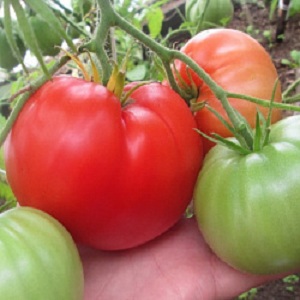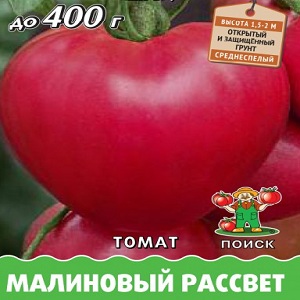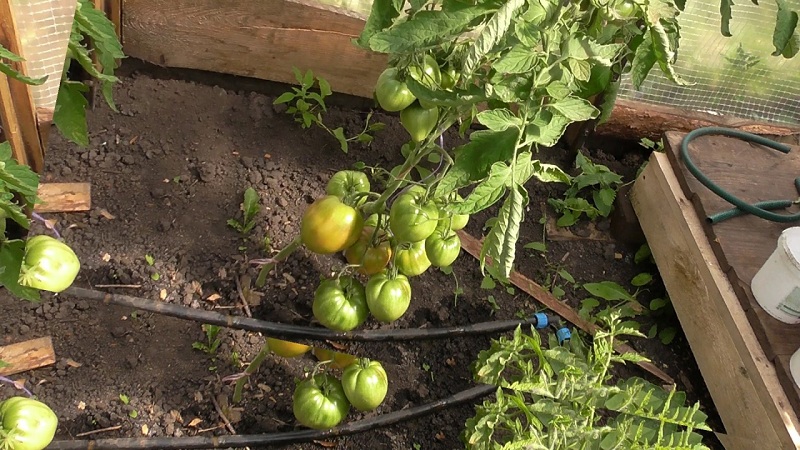Salad variety with fleshy pulp - tomato "Raspberry Dawn"
The Raspberry Dawn variety belongs to the group of tomatoes with a raspberry color, which combines undemanding care and wonderful taste. Sugar juicy pulp combined with thin skin, attractive heart-shaped shape will leave few people indifferent.
In this article, we will tell you in detail about the features of the variety, the intricacies of its cultivation in a greenhouse and garden, possible difficulties and methods of combating late blight and insects.
The content of the article
Characteristics and description of the variety
The mid-season variety Raspberry Dawn was created by the breeders of the Poisk agrofirm. It was included in the State Register of the Russian Federation in 2015. The culture is grown in greenhouses, hotbeds and open field. Indeterminate bushes are formed into 2-3 stems and tied to supports.
The photo shows the Raspberry Dawn tomatoes.

Distinctive features
The table shows the main characteristics of tomatoes:
| Indicators | Characteristic |
| Weight | 350-400 g |
| The form | Heart-shaped, ribbed |
| Coloration | Dark crimson |
| Leaves | Small, green |
| Inflorescence type | Simple articulated |
| Number of nests | More than six |
| Pulp | Medium density, grainy |
| Taste | Sugar with pleasant sourness |
| Skin | Thin |
| Appointment | Salad |
| Bushes height | 1.8 m |
| Ripening period | 110-115 days after germination |
| Yield | 8-15 kg / m² |
| Sustainability | To fusarium and tobacco mosaic virus |
| Transportability | High |
Growing seedlings
The Raspberry Dawn tomatoes are grown through seedlings. Sowing is carried out in the last decade of March - the first decade of April, 60–65 days before transfer to the ground.
Soil preparation and sowing
 The seed does not need additional disinfection, since it is processed in production. To increase germination, the grains are soaked in a growth stimulator - "Zircon" or "Epine".
The seed does not need additional disinfection, since it is processed in production. To increase germination, the grains are soaked in a growth stimulator - "Zircon" or "Epine".
Seeds collected by hand from previously grown tomatoes are disinfected in a 2% peroxide solution for 10 minutes or in a pink solution of potassium permanganate (30 minutes).
For growing seedlings, universal soil in bags from gardening stores is suitable. You can prepare the soil yourself.
This will require:
- 3 parts of vermicompost;
- 2 parts river sand;
- 1 part peat;
- 1 part perlite.
Before sowing, the soil is disinfected by heating it in an oven or microwave, or spilling it with a strong solution of potassium permanganate. Then the containers are filled with cooled earth, grooves of 2 cm are made and the seeds are spread with an interval of 2 cm. 1 cm of soil is poured on top, the containers are covered with a film for a greenhouse effect and taken to a warm, dark place.
The film is lifted daily to ventilate the soil. This will help prevent mold growth. The first shoots appear at a temperature of +23 ° C in 4-5 days.
Seedling care
After the emergence of seedlings, the containers are taken out to the sunniest place in the house and the film is removed. Watered once every 5-7 days. Weak shoots are periodically removed, leaving only strong ones.
After the seedlings reach 10 cm in height, they are dived into separate glasses made of peat or plastic.
Eggshell feeding helps to strengthen the vitality of the seedlings. To do this, it is pre-dried and ground into powder using a coffee grinder. Add 2-3 tbsp to 1 liter of water. l. powder and insist for a week. Cloudy water and an unpleasant odor indicate that the fertilizer is ready.Before watering, the infusion is diluted with water in a ratio of 1: 3. The frequency of feeding is once a week.
Agrotechnics of tomatoes
The rules for growing tomatoes are no different from the cultivation of other varieties of raspberry color. The culture is characterized by unpretentious care, needs moderate watering, a garter of indeterminate bushes, pinching and fertilizing.
Landing
The transfer of seedlings to a greenhouse or vegetable gardens begins in late May - early June. By this time, the soil will have time to warm up and the threat of night frosts will disappear.
Raspberry Dawn tomatoes love loose, nutritious soil. They prepare it in the fall, digging up and fertilizing with humus. In the spring, the soil is re-loosened and fed with humus (10 liters per 1 m²).
Fortified bushes are planted in the evening or in cloudy weather in pits to a depth of 20 cm. Before this, the wells are disinfected with a dark solution of potassium permanganate. Planting scheme - 50 × 70 cm (no more than 3 plants per 1 m²).
After planting, the soil is mulched with sawdust, peat or needles. Mulch retains moisture, prevents bacteria and weed growth.
Care
Bushes form 2-3 stems. Pickling is carried out every 10 days. Shoots are removed from the leaf axils after reaching 5 cm in length using garden shears, a sharp knife, or gently broken off by hand. Bushes are tied to a trellis or long supports.
Tomatoes prefer moderate watering: 2 times a week, 7 liters per bush.
Ready-made compositions are used as top dressing: Agricola, Kemira. They replenish reserves of zinc, potassium, magnesium, phosphorus, manganese, stimulate the appearance of ovaries, accelerate ripening. The frequency of application of foliar fertilizers is 1 time in 15 days.
Home-made feeding made from pressed yeast and eggshells is excellent.

Yeast top dressing recipes:
- Dissolve 200 g of fresh yeast in 1 liter of warm water and leave for 3 hours. Dilute the resulting concentrate with settled water (1:10).
- Add 1 bucket of fresh herbs (hops, plantain, nettle) and 300 g of yeast to a barrel of water (50 l). Insist 48 hours.
- 100 g of sugar, 50 g of fresh yeast, 500 g of ash, 500 g of chicken manure. Infuse the mass for 2 days and dilute in 10 liters of water.
Fertilizers are used once every 10-14 days. The eggshell infusion described above is used for adult tomatoes twice a month.
Features of cultivation and possible difficulties
The variety is distinguished by its unpretentiousness to weather conditions and shows excellent results when cultivated in open and closed ground.
The only difficulty that can be encountered is loss of taste in the fruit and cracking of the skin. This is due to excess moisture. The fruits become sour and watery and lose their flavor. To avoid this, water in the evening strictly at the root, trying not to get on the leaves.
Advice... The best solution is to install drip irrigation. So the earth will always be moistened, but in moderation.
Diseases and pests
The variety is resistant to fusarium and tobacco mosaic virus, but susceptible to late blight.
Prevention methods help prevent infection:
- airing and fumigating greenhouses with sulfur bombs;
- moderate watering;
- mulching soils with sawdust, hay, needles, peat;
- making potassium-phosphorus dressings;
- control of nitrogen levels in the soil;
- soil disinfection copper sulfate;
- loosening the beds after watering.
Fungicides for tomatoes will help to cope with the infection: "Quadris", "Acrobat", "Ridomil", "Agat", "Fundazol", Bordeaux mixture, "Strobi". Manufacturers indicate the dosage and method of dilution on the packaging.
Help in the fight aphids, spider mite, whitefly, drugs "Fitoverm", "Epin", "Flumite", "Borneo", "Aktara", "Zircon" will come by the bear.

Those who prefer more environmentally friendly products prepare infusions of herbs, ash, onion husks:
- 200 g onion skins pour 10 liters of water and leave for 6-7 hours, then pour in 25 ml of liquid soap. Process tomatoes with a solution 1 time in 7 days.
- 30 g ash and 30 ml soap dissolve in 5 liters of water and strain through a thin cloth. Spray the bushes once every 14 days.
- 200 g dandelion roots pour 10 liters of warm water, leave for 2 hours, then strain. Use once every 2 weeks.
- Pour 200 g of young needles 500 ml of water, infuse for 7 days. Dilute with water (1:10) before use. Irrigate tomatoes once every 2 weeks.
- 1 kg freshly chopped celandine herb pour 5 liters of water, leave for 24 hours. Apply twice a month.
- Slugs are best dealt with by hand picking or spraying the bushes. ammonia (2 tbsp. l. substance per 5 liters of water).
Advice... Plant marigolds, odorous dill, chamomile, basil, mint, and fennel near tomatoes to attract beneficial insects that eat aphids.
The nuances of growing in an open field and a greenhouse
Raspberry Dawn care outdoors and indoors does not make much difference. Planting in the garden is carried out a week later than in the greenhouse. This is due to the thermophilicity of the variety and the threat of night frosts. The optimum soil temperature for transferring seedlings is +16 ° C.
To achieve good results, it is important to provide a comfortable watering regime, apply top dressing on time and form bushes into 2 stems.
Greenhouses are regularly ventilated. The air humidity is maintained at 60%.
Tomatoes in the garden for the first time after planting are covered overnight with agrofibre to protect them from the cold and attacks of insect pests.
Collection and application of tomatoes
Harvesting begins 110-115 days after the emergence of shoots. Thanks to the sugary juicy pulp with a slight sourness, tomatoes are ideal for fresh consumption. They make excellent juices with a rich taste and aroma, sauces. Whole tomatoes are not suitable for preservation because of their large size.

Advantages and disadvantages
Advantages of the Raspberry Dawn variety:
- wonderful taste;
- excellent presentation;
- large fruits;
- high productivity;
- unpretentious care;
- possibility of transportation;
- resistance to viral diseases;
- the ability to grow in any climatic conditions of the country in open and closed ground;
- thin skin.
The variety has fewer disadvantages. This is the need for a garter and formation of plants and cracking of the skin with an excess of moisture.
Reviews
There are only positive reviews about the Raspberry Dawn variety:
Vladislav, Yaroslavl: “The Raspberry Dawn Tomatoes have been in my greenhouse since the seeds went on sale. The variety does not need special care, it tolerates heat and cold well. Tall bushes require a tie to the supports. The taste of the fruit is excellent, the pulp is sweet, slightly grainy. "
Igor, Penza: “I have been growing these tomatoes in the greenhouse for three years in a row. The result is always pleasing. The fruits are large, especially the lower ones. Some reach a weight of 1 kg. The skin is thin, the pulp is sweet, there is a slight sourness. I water it twice a week, feed it with phosphorus-potassium fertilizers. "
Maria, Orenburg: “The Raspberry Dawn tomatoes are one of my favorites. I plant seedlings at the end of March and transfer them to a greenhouse at the end of May. I tie the bushes to a trellis and form them into two stems. Thus, I achieve the maximum yield. I collect 5-6 kg from one bush. "
Conclusion
Raspberry Dawn is a high-yielding tomato variety that shows excellent results when cultivated in different climatic zones of Russia, both outdoors and indoors.
Up to 15 kg of fruits are harvested from one square meter, subject to the principles of agricultural technology: the formation of bushes in 2 stems, moderate watering and top dressing with complex compositions. Fruits with sugary pulp are suitable for fresh consumption, making rich juices and sauces.